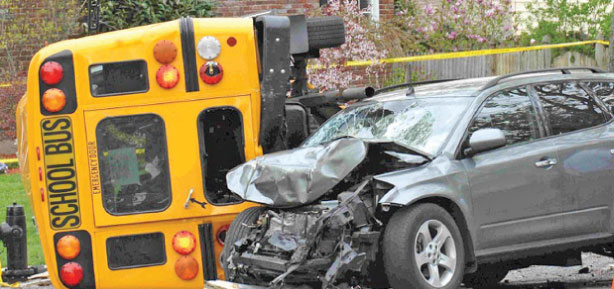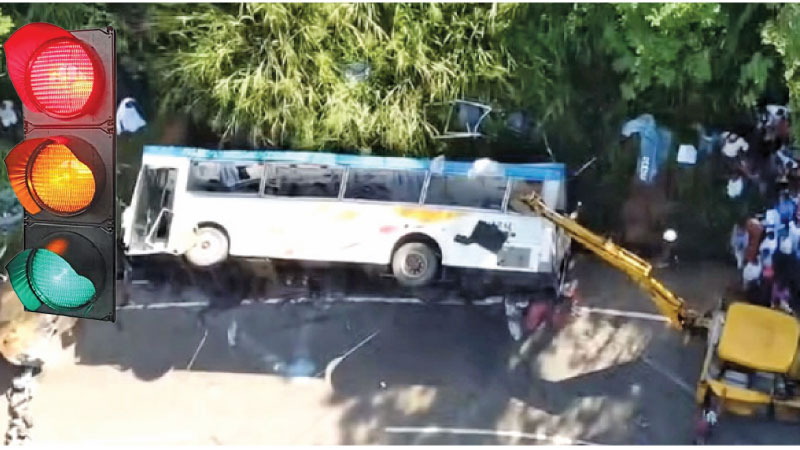 If you watch the TV news on any channel, you will see horrific visuals of car crashes and news items giving details of the same. In one of the most recent accidents, two promising female students of the Kothalawala Defence University (KDU) were killed when their bus veered off the road and toppled in mountainous terrain. The driver, who was injured, turned out to be driving on a bogus drivers’ licence, his real one having been confiscated several months ago after another accident.
If you watch the TV news on any channel, you will see horrific visuals of car crashes and news items giving details of the same. In one of the most recent accidents, two promising female students of the Kothalawala Defence University (KDU) were killed when their bus veered off the road and toppled in mountainous terrain. The driver, who was injured, turned out to be driving on a bogus drivers’ licence, his real one having been confiscated several months ago after another accident.
In fact, the Police and Department of Motor Traffic Department statistics reveal that one road death occurs every four hours in Sri Lanka. Nearly 110 road accidents, including those fatal, occur every day around the island. This is an alarmingly high accident rate. Pedestrians, cyclists and motorcyclists are the biggest victims.
Nearly 2,000 persons have been reported dead in road accidents reported during the first 10 months of 2024, Police Spokesman DIG Nihal Thalduwa said. DIG Thalduwa said that from January 1 to October 25, of the 1,818 accidents were reported nationwide. The accidents had resulted in the deaths of 1,898 persons out of which 676 were pedestrians. The Police Spokesman said Sri Lanka had recorded 2,557 deaths in 2,200 road accidents in 2023.
A leading killer
Worldwide too, a large number of traffic accidents occur every day. The Global status report on road safety, launched by WHO in December 2018, highlights that the number of annual road traffic deaths has reached 1.35 million. Road traffic injuries are now the leading killer of people aged 5-29 years. The burden is disproportionately borne by pedestrians, cyclists and motorcyclists, in particular those living in developing countries.
It is a great tragedy that deserves more attention. This is why the UN has designated a World Day for Remembrance of Road Traffic Victims. The Day falls on the third Sunday of every month (this year, November 17).
More than half of all road traffic deaths are among vulnerable road users: pedestrians, cyclists, and motorcyclists. Pedestrians, cyclists, and riders of motorised 2- and 3-wheelers and their passengers are collectively known as “vulnerable road users” and account for half of all road traffic deaths around the world. A higher proportion of vulnerable road users die in low-income countries than in high-income countries. Road traffic injuries cause considerable economic losses to individuals, their families, and to nations as a whole. These losses arise from the cost of treatment as well as lost productivity for those killed or disabled by their injuries, and for family members who need to take time off work or school to care for the injured. Road traffic crashes cost most countries 3% of their gross domestic product.
Health and social cost of accidents
Indeed, we tend to forget the massive health and social cost of accidents. The Sri Lankan State spends millions of rupees every year on treating around 20,000 accident victims around the island, from those who sustain minor injuries to those who are left in a critical condition after accidents. For example, the Government spends nearly Rs.3 million to treat a victim with a spinal cord injury. Thus, accidents are a major health problem too. In fact, the number of deaths reported due to accidents is higher than the number of deaths caused by dengue and Non-Communicable Diseases (NCDs).
Accidents lead to permanent disabilities for some victims, turning it into a social problem as well. The majority of road victims in Sri Lanka are aged 15 – 45. This also means the removal from the working population of healthy young men and women who could have made a major contribution to the economy had they not been killed, injured or maimed. Road accidents affect the economy as well.
Many accidents (and hence the injuries) are avoidable or preventable. However, this is easier said than done until our motorists get more disciplined behind the wheel. With most drivers unaware of the very existence of the Highway Code, road signs and other road rules, it is a tall order.
One cannot blame the motorists alone – jaywalking is still very common here and many pedestrians are knocked down by vehicles. Ironically, even developed countries face the problem of jaywalking. Unable to cope with it, New York recently legalised the dangerous practice, with the caveat that the pedestrian is responsible for any accident.
One other factor, often overlooked, is the large number of vehicles in the country – nearly 8.5 million – with more than 50 percent of them being motorcycles and scooters. This will expand rapidly once vehicle imports resume in February next year. The limitations of the road network also contribute to this situation. Police say that most of the accidents involve motorcycles and three-wheelers. Private buses are also frequently involved in accidents.
Reasons
What are the prime reasons for accidents? Reckless driving, Driving Under the Influence of liquor (DUI), not obeying road signs/signals, speeding, disregarding road rules and using hand-held mobile phones while driving are among them. Some vehicles are also mechanically unsound and well past their prime. Many countries send them to the scrap yard and give the owner a rebate to buy a new vehicle.
Police have also advised pedestrians not to use mobile phones, especially when crossing the road (and while walking on or near railway tracks, which in itself is prohibited). Some accidents are also caused by inexperienced drivers.
The Government plans to bring in a Driver Improvement Points System (DIPS) for motorists, as implemented in many other countries. The authorities hope that the DIPS would lead to more disciplined and road-rule abiding drivers, as those who exceed a certain number of points for traffic offences within two years, would have their license suspended for a year. The number of points one ‘earns’ would depend on the severity of the offence committed. This is a commendable move. Driving schools should also be closely regulated and all new drivers must be required to drive with a ‘P’ or probationary period for one year, as done in many other countries. There are also many who drive without a license or on bogus licenses, as was the case with the KDU bus driver. These instances should be looked into.
Some accidents may be inevitable, but the truth is that 95 percent of accidents can be avoided if drivers (and cyclists and pedestrians) obey road rules and maintain road discipline. Each driver must be very careful on our roads, because not many adhere to road rules. If more and more drivers drive carefully, fewer accidents will happen.
We have heard the common refrain ‘speed kills’ and in this case, it is true. Speed limits are imposed for a reason and sometimes even if a speed limit is not specified, a driver should gauge a safe speed according to traffic, road and weather patterns. Drivers should be even more careful at night or in heavy rain when visibility is drastically reduced. Even the latest high intensity light systems, which can pose a risk to oncoming traffic, cannot compensate for daylight. Drivers must also adhere to the 100 Kmph limit on expressways – Sri Lankan express are not the Autobahn yet.
Avoid driving drunk
The other big problem is drunk driving. DUI reduces one’s attention levels and dulls the senses. It is easy to make a fatal mistake in a DUI situation. There are motorists who feel they can handle a glass or two of alcohol (and indeed there is a tolerable blood alcohol limit for the purpose of driving or operating machinery), but that is not a very good approach. If you are drunk, get another sober person to drive or call a three-wheeler or ride hailing service. There are also services which send a driver to drive your own car. That may save a life – yours or someone else’s – not just your license.
Car makers and governments are striving to make driving and roads safer and smarter. Many cars already have lane departure warning systems, brake assist, sleepiness alert warning systems, electronic stability control, multiple airbags (including pedestrian airbags), night vision systems and even pre-crash systems which readies the car for an imminent crash to save the lives of passengers on board. Cars are also becoming more intelligent. Many Tesla, Cadillac and Ford cars have limited autonomous driving capabilities even now, but Level 5 autonomy when the car does all the driving is not widespread yet. Tesla recently unveiled a Robotaxi that can do exactly that, while Google’s Waymo service already has several driverless taxis.
 Traffic authorities are working on ‘smart’ roads and traffic management systems which should help prevent accidents. In the future, driverless cars will “talk” to each other, traffic lights, road signs and even avoid collisions without our knowledge. At least until then, nothing can replace a disciplined driver behind the wheel. And we need millions of them to see a world free of road traffic victims.
Traffic authorities are working on ‘smart’ roads and traffic management systems which should help prevent accidents. In the future, driverless cars will “talk” to each other, traffic lights, road signs and even avoid collisions without our knowledge. At least until then, nothing can replace a disciplined driver behind the wheel. And we need millions of them to see a world free of road traffic victims.
Since the adoption of the World Day of Remembrance for Road Traffic Victims, pursuant to General Assembly resolution 60/5, the observance has spread to a growing number of countries on every continent.
The Day has become an important tool in global efforts to reduce road casualties. It offers an opportunity for drawing attention to the scale of emotional and economic devastation caused by road crashes and for giving recognition to the suffering of road crash victims and the work of support and rescue services.
The objectives of the World Day of Remembrance for Road Traffic Victims are to provide a platform for road traffic victims and their families to: remember all people killed and seriously injured on the roads; acknowledge the crucial work of the emergency services; draw attention to the generally trivial legal response to culpable road deaths and injuries; advocate for better support for road traffic victims and victim families; promote evidence-based actions to prevent and eventually stop further road traffic deaths and injuries.
Dedicated website
A dedicated website was launched to make the Day more widely known and to link countries through sharing common objectives and the remembrance of people killed and injured in crashes.
In September 2020, the UN General Assembly adopted resolution A/RES/74/299 “Improving global road safety”, proclaiming the Decade of Action for Road Safety 2021-2030, with the ambitious target of preventing at least 50 percent of road traffic deaths and injuries by 2030. This target should be attainable, if disciplined drivers take the wheel worldwide.









